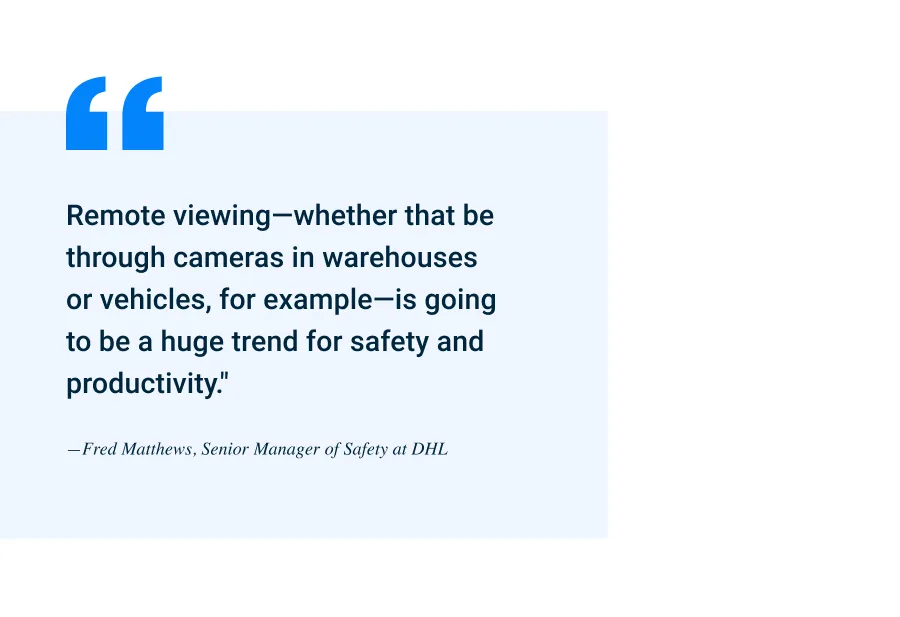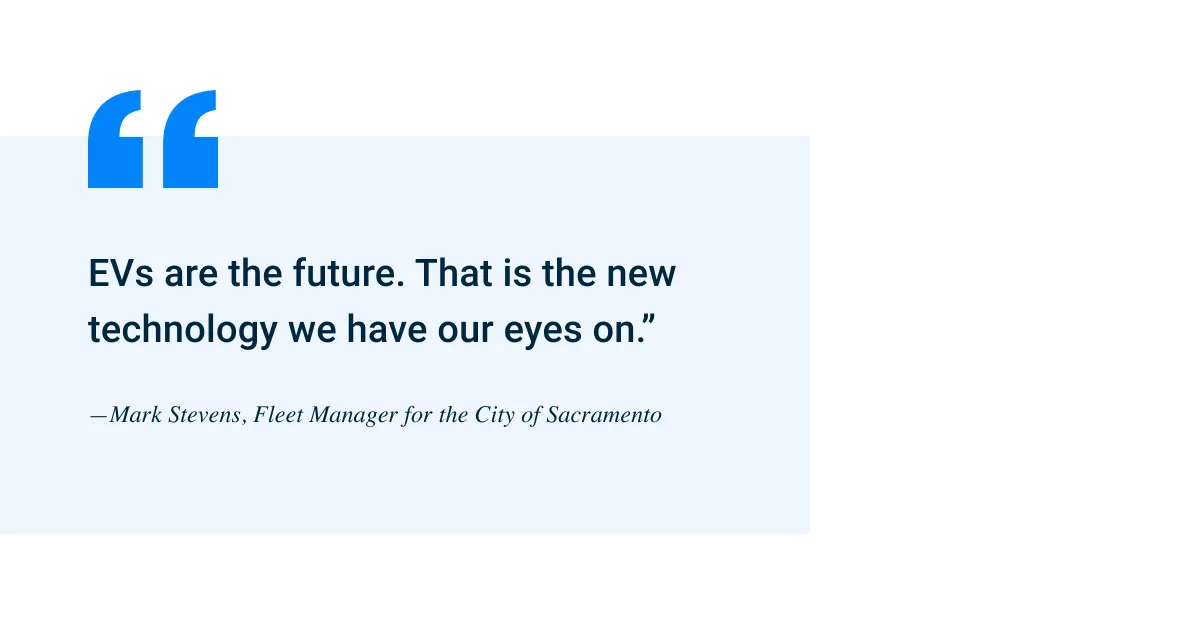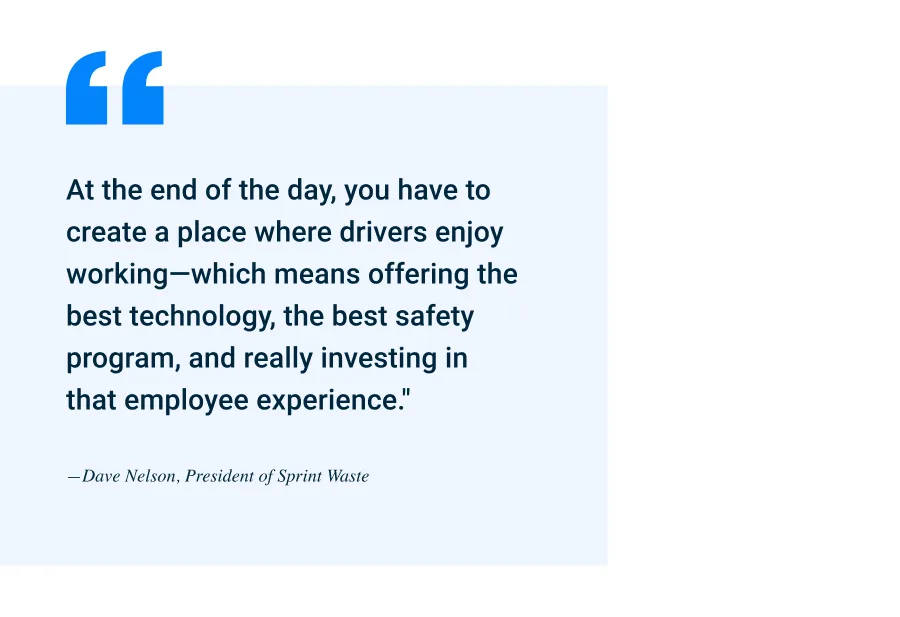Efficiency
6 Predictions for 2021: Trends in Connected Operations
January 13, 2021
Manager, Content Marketing

Get the latest from Samsara
Subscribe nowAs we kick off a new year and celebrate a big milestone for the Samsara community (20,000 customers!), we’re excited to see what the world of connected operations will look like in 2021 and beyond. This year, we asked our partners and customers: what trends, developments, or new technologies will be important in 2021? Here are our predictions based on those conversations:
<a href="#section-1">Operations will become increasingly remote, enabled by IoT</a><a href="#section-2">Renewed infrastructure investment will usher in a "digitization" of roadways</a><a href="#section-3">AI and sensor fusion will revolutionize operational safety</a><a href="#section-4">Autonomous vehicles will continue to progress, but remain on the horizon for the commercial market</a><a href="#section-5">Heavy duty EVs will be the next frontier in fleet electrification, and state and local governments will be the first adopters</a><a href="#section-6">Demand for commercial drivers will increase, making recruitment and retention more important than ever</a>
<div id="section-1">1. Operations will become increasingly remote, enabled by IoT</div>
In 2020, the COVID-19 pandemic meant many businesses had to “go remote” overnight. We predict this shift will continue even after the pandemic ends, with fleet, warehousing, and supply chain operations becoming increasingly remote.
“What I see on the horizon is a massive shift in the way businesses do business,” said Fred Matthews, Senior Manager of Safety at DHL. “This pandemic opened up business leaders’ mindsets to the possibilities of remote operations, and how we can work smarter with virtual tools.”
Internet of Things (IoT) technology that enables remote visibility and communication will make this long-term shift possible by connecting every step of the supply chain—from warehouse to driver to customer. For example:
Driver safety workflows that used to require mainly in-person interaction (like driver ride-alongs and personalized coaching sessions) will increasingly be done via in-cab cameras and mobile devices.
Connected cameras and sensors will increasingly be used for warehouse worker safety and efficiency.
In-person visits to remote infrastructure will no longer be needed with real-time monitoring and control.
“In 2020, technology enabled us to stay in touch with our different regions about their safety protocols and what their drivers were doing, despite being in entirely different locations and not having any in-person interactions,” said Shep Nelson, Equipment Manager at Goodfellow Bros. “It’s why we’re investing more in this technology and building out safety programs around it in 2021.”
Matthews agreed: “Remote viewing—whether that be through cameras in warehouses or vehicles, for example—is going to be a huge trend for safety and productivity. We saw the benefits of remote operations in 2020, and in 2021 we’re finding new ways to connect our operations virtually.”

<div id="section-2">2. Renewed infrastructure investment will usher in a "digitization" of roadways</div>
President-elect Biden’s infrastructure plan includes a pledge to “make American roads the world’s safest,” with increased federal funding for key safety initiatives. This means that in 2021, more public investment will likely be available for infrastructure improvements related to road safety. We predict this will usher in a new era of advanced roadway safety analytics, known as “roadway digitization," to help inform these infrastructure improvements with data-driven insights.
“Historically, there’s been incomplete data on the ‘built environment’ to help us confidently predict what infrastructure improvements will move the needle for injuries and crashes,” said David Braunstein, President of Together for Safer Roads. “Crash, injury and fatality statistics are all lagging indicators. If you don't know where the riskiest intersections are, or where the riskiest road segments are, you're always playing catch up.”
“Roadway digitization” has been discussed for years as a way to inform more data-driven infrastructure improvements, and has even been tested successfully in some cities. With a renewed federal focus on infrastructure in 2021, we anticipate this will be the year that “roadway digitization” finds a bigger spotlight (and more funding) across U.S. cities and states.
“The digitization of the roadway has the potential to unlock smarter infrastructure improvements,” said Braunstein. “It’s just a question of when—and the recommitment to infrastructure investment in 2021 is very timely.”
<div id="section-3">3. AI and sensor fusion will revolutionize operational safety</div>
Over the past few years, we’ve seen emerging technologies transform the field of operational safety. Artificial intelligence (AI), for example, has made it possible to detect and coach commercial drivers on behaviors like tailgating and distracted driving before they cause an accident. And in warehouses, AI-powered site visibility can now provide early warning signals to help prevent the half a million injuries per year that happen in manufacturing alone.
With new safety precautions becoming more commonplace across commercial fleets, warehousing, and worksites due to COVID-19, the next frontier for operational safety technologies in 2021 and beyond is sensor fusion.
Sensor fusion combines data from multiple sensors to provide more actionable insights than if sensors were used independently. Sensor fusion is already here—for example, Samsara AI Dash Cams (which have embedded AI) are connected to Samsara Vehicle Gateways (which provide GPS, acceleration data, g-force data, and more).
The combination of these data points makes it possible to accurately detect high-risk behaviors and prevent safety incidents in real time. As more types of sensors come online—and they each get better at what they do—sensor fusion will revolutionize operational safety in the vehicle, warehouse, and beyond.
“What makes sensor fusion so exciting is that the individual technologies—computer vision, radar, thermal sensing—are also maturing,” said David Braunstein, President of Together for Safer Roads. “We are at a tipping point that could revolutionize collision avoidance and prevention.”

<div id="section-4">4. Autonomous vehicles will continue to progress, but remain on the horizon for the commercial market</div>
Autonomous vehicle (AV) technology has seen huge advancements over the past few years. But while AV technology will undoubtedly continue to advance in 2021, we predict that commercial adoption remains many years ahead.
“There's a lot of hype around driverless vehicles because there have been significant advancements in the technology,” said Fred Matthews, Senior Manager of Safety at DHL. “But with the complexity of our operations, I don’t see over-the-road trucking becoming autonomous quite yet. As a first step, I could see ‘point A to point B’ driverless trucking coming online maybe within the next decade.”
Dave Nelson, President of Sprint Waste, agreed: “We don’t see autonomous vehicles being part of our fleet yet, at least for the near future. The complexity of what our drivers have to do in waste transportation is more involved than what is currently possible with AV technology, so for us we see it a little further down the road.”
<div id="section-5">5. Heavy duty EVs will be the next frontier in fleet electrification, and state and local governments will be the first adopters</div>
While autonomous vehicles may still be some years on the horizon, we predict that electric vehicles (EVs) will penetrate the commercial market in 2021 at an accelerating pace.
“Sustainability is going to be an area to watch for 2021,” said Fred Matthews, Senior Manager of Safety at DHL. “With the new presidential administration coming in, there's a bigger focus on sustainability. And at the same time, EV technology is getting better and better from a fleet perspective.”
Indeed, battery technology continues to advance, improving light duty EV performance—and making heavy duty EVs a possibility for the commercial market. However, heavy duty EVs won’t be adopted across all industries at the same time. We predict state and local governments will be the first adopters, for a few reasons:
Infrastructure: Many government fleets have already adopted light duty EVs, meaning they already have EV infrastructure in place, including charging stations and EV fleet management tools. This makes the barrier to adoption much lower.
Incentives: Even if no new federal sustainability guidelines are implemented, statewide sustainability goals, like California’s Zero-Emission Vehicle Program, could drive some cities towards heavy duty EV adoption.
Services: Many of the services that state and local governments provide, like trash pickup, are uniquely suited to EV adaptation due to their predictable, recurring routes. Plus, heavy duty government vehicles typically travel within a smaller radius compared to other commercial heavy duty vehicles, meaning heavy duty EV range may be less of a concern.
“Focusing on class 8 vehicles is, I think, the next step in the evolution of EV technology,” said Mark Stevens, Fleet Manager for the City of Sacramento, which is testing out their first 100% battery-electric garbage truck for a trial period in 2021.
“We’ll be evaluating questions like: What are the downsides? Does it have enough range? Is the compaction rate high enough for this type of operation? We hope to have that vehicle in service in 2021,” said Stevens. “I definitely think that EVs are the future. That is the new technology we have our eyes on.”

<div id="section-6">6. Demand for commercial drivers will increase, making recruitment and retention more important than ever</div>
Finally, one long-term trend we predict will persist throughout 2021 and beyond is the national truck driver shortage.
“The national truck driver shortage is something we believe is a long-term issue,” said Dave Nelson, President of Sprint Waste. “We have an aging employee demographic for commercial drivers, and we're not seeing as many young people wanting to become commercial drivers.”
The COVID-19 pandemic may have worsened the driver shortage by simultaneously suppressing the supply of commercial drivers and increasing demand. Due to the pandemic, a significant number of commercial driver’s license (CDL) training schools are closed or operating at reduced capacity, leading to a 40% drop in CDL training. At the same time, trucking demand has surged.
“Even before COVID, the demand for commercial drivers was already high. Now, with more and more companies shipping goods and fulfilling those online orders, I think that's going to push up the demand for drivers in logistics and transportation even more,” said Fred Matthews, Senior Manager of Safety at DHL. “I think it’s going to be a much bigger market than it already is.”
This means recruitment and retention will become even more important in 2021. We may see businesses offer even higher signing bonuses or pay increases to attract talent.
“You have to be competitive with pay,” said Nelson. “But at the end of the day, you have to create a place where drivers enjoy working—which means offering the best technology, the best safety program, and really investing in that employee experience.”

Looking forward to 2021 and beyond
Do you have a prediction about the future of connected operations? We want to hear from you! Tweet @Samsara on Twitter to share your predictions for 2021 and beyond.
Thank you to our partners who shared their perspectives with us for this blog, including Fred Matthews, Dave Nelson, Mark Stevens, Shep Nelson, and David Braunstein.
Get the latest from Samsara
Subscribe now

















